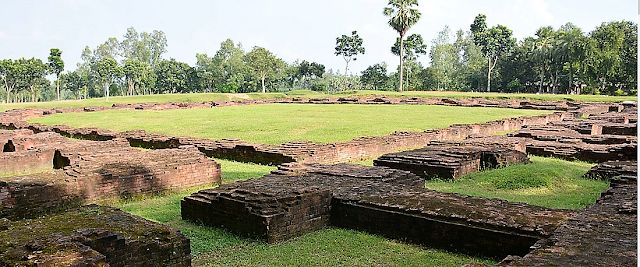Mahasthangarh is one of the most ancient cities in Bangladesh. It has a significant archaeological importance in the history of Bangladesh. Bihar Dhap is an important archaeological site in Shibganj Upazila of Bogra district. It is also locally known as Totaram Pandit's step or the home of Totaram Pandit.
Location: The site is located in the village of Bihar in Shibganj, Bogra. Nagar river flows west and south of it.It is located about four kilometers northwest of Mahasthangarh and about one kilometer from Bhasu Bihar.
History of the site: Famous Chinese traveler Hiuen Tsang (638-645 AD) During this period traveled to this region of Bengal. He referred to a monastery named Po-Si-Po Bihar at 6 km west of Mahasthangarh. It is believed that this monastic phase is the Po Che-poh Bihar. There was a continuous excavation work from 1979-1986.
In addition to this, two Buddhist monasteries along the west side and a temple structure on the east were partially opened. Later, excavation work was carried out again in 2005-06. Then a section of the ruins of another temple was exposed besides the previously discovered temple. Two temples are north-facing.
There are more than 1,000 different types of artifacts that have been found here due to excavation at different times. Among them, the bronze meditative Buddha statue, silver coins, glass beads, 60 terracotta plaques, burnt seals, patches, earthenware, 100 designs made bricks, iron nails etc.
By analyzing the characteristics of archaeological remains and related artifacts of the first construction period, the period of this era was determined by four or five centuries. It is believed that the second and third years of the six to the 10th century. Old brick recycling has been observed in many ways in the architecture of the fourth to the fifth generation. It is further estimated that at least some time from the eleventh to the 12th century this place fell.
History of the site: Famous Chinese traveler Hiuen Tsang (638-645 AD) During this period traveled to this region of Bengal. He referred to a monastery named Po-Si-Po Bihar at 6 km west of Mahasthangarh. It is believed that this monastic phase is the Po Che-poh Bihar. There was a continuous excavation work from 1979-1986.
In addition to this, two Buddhist monasteries along the west side and a temple structure on the east were partially opened. Later, excavation work was carried out again in 2005-06. Then a section of the ruins of another temple was exposed besides the previously discovered temple. Two temples are north-facing.
There are more than 1,000 different types of artifacts that have been found here due to excavation at different times. Among them, the bronze meditative Buddha statue, silver coins, glass beads, 60 terracotta plaques, burnt seals, patches, earthenware, 100 designs made bricks, iron nails etc.
By analyzing the characteristics of archaeological remains and related artifacts of the first construction period, the period of this era was determined by four or five centuries. It is believed that the second and third years of the six to the 10th century. Old brick recycling has been observed in many ways in the architecture of the fourth to the fifth generation. It is further estimated that at least some time from the eleventh to the 12th century this place fell.









quite interesting story :)
ReplyDeletegreat, keep it up
ReplyDeletegreat, keep it up
ReplyDeleteWow interesting 😊😊
ReplyDeleteNice info keep it up
ReplyDeleteAmazing places to discover, you always catch me with your articles, thanks
ReplyDeleteperfect article for students looking for other architectural wonders. :D Aside from the usuals like eiffel tower :)
ReplyDeleteI really love the article. Share more please
ReplyDeleteIt's amazing, really nice to see.
ReplyDeleteVery well written article keep it up
ReplyDeleteThis is interesting! Hope to visit this place someday!
ReplyDeleteWould really like to visit here some day!
ReplyDelete